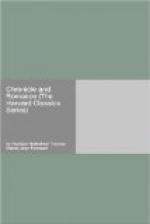nation used the word erne in most places for the eagle.
We have also the lanner and the lanneret, the tersel
and the goshawk, the musket and the sparhawk, the
jack and the hobby, and finally some (though very
few) marleons. And these are all the hawks that
I do hear as yet to be bred within this island.
Howbeit, as these are not wanting with us, so are
they not very plentiful: wherefore such as delight
in hawking do make their chief purveyance and provision
for the same out of Danske, Germany, and the eastern
countries, from whence we have them in great abundance
and at excellent prices, whereas at home and where
they be bred they are sold for almost right nought,
and usually brought to the markets as chickens, pullets,
and pigeons are with us, and there bought up to be
eaten (as we do the aforesaid fowl) almost of every
man. It is said that the sparhawk pryeth not
upon the fowl in the morning, that she taketh over
even, but as loath to have double benefit by one seelie
fowl doth let it go to make some shift for itself.
But hereof as I stand in some doubt. So this
I find among the writers worthy the noting: that
the sparhawk is enemy to young children, as is also
the ape, but of the peacock she is marvellously afraid,
and so appalled that all courage and stomach for a
time is taken from her upon the sight thereof.
But to proceed with the rest. Of other ravenous
birds we have also very great plenty, as the buzzard,
the kite, the ringtail, dunkite, and such as often
annoy our country dames by spoiling of their young
breeds of chickens, ducks, and goslings, whereunto
our very ravens and crows have learned also the way:
and so much are ravens given to this kind of spoil
that some idle and curious heads of set purpose have
manned, reclaimed, and used them instead of hawks,
when other could not be had. Some do imagine
that the raven should be the vulture, and I was almost
persuaded in times past to believe the same; but, finding
of late, a description of the vulture, which better
agreeth with the form of a second kind of eagle, I
freely surcease to be longer of that opinion:
for, as it hath, after a sort, the shape, colour, and
quantity of an eagle, so are the legs and feet more
hairy and rough, their sides under their wings better
covered with thick down (wherewith also their gorge
or a part of their breast under their throats is armed,
and not with feathers) than are the like parts of
the eagle, and unto which portraiture there is no
member of the raven (who is almost black of colour)
that can have any resemblance: we have none of
them in England to my knowledge; if we have, they
go generally under the name of eagle or erne.
Neither have we the pygargus or grip, wherefore I have
no occasion to treat further. I have seen the
carrion crows so cunning also by their own industry
of late that they have used to soar over great rivers
(as the Thames for example) and, suddenly coming down,
have caught a small fish in their feet and gone away
withal without wetting of their wings. And even




